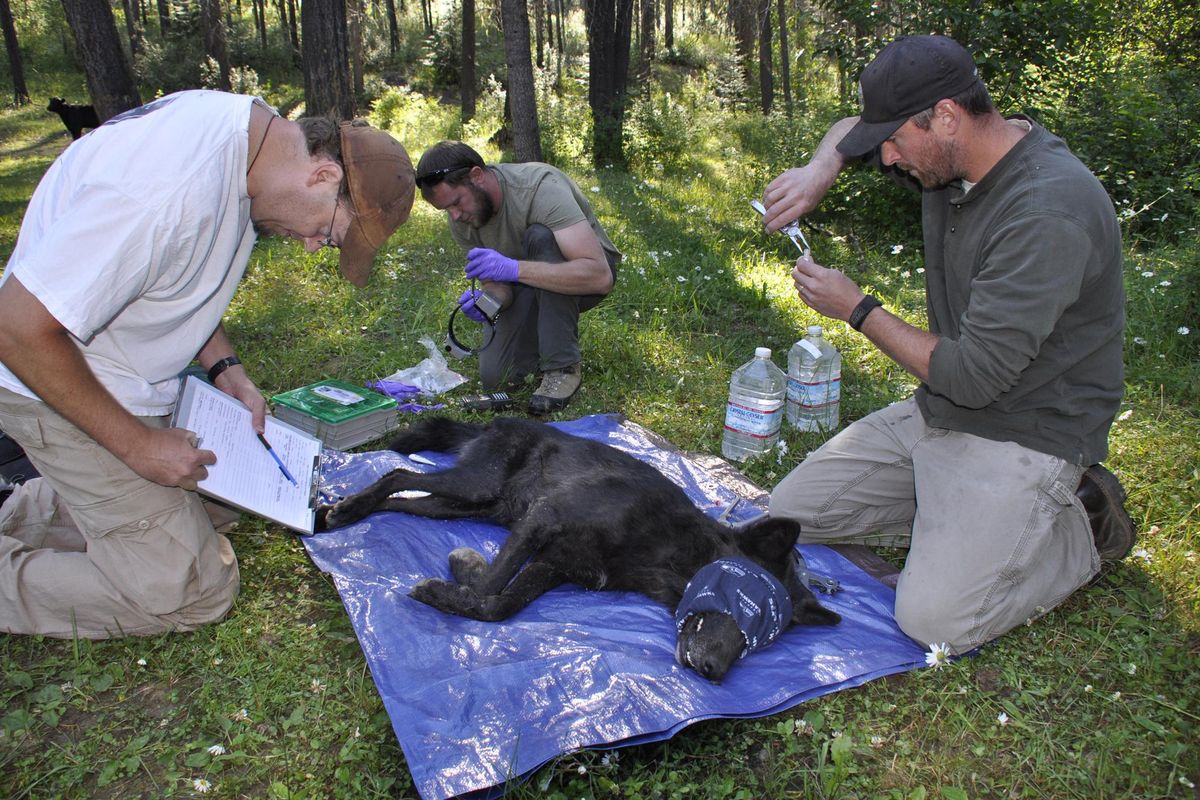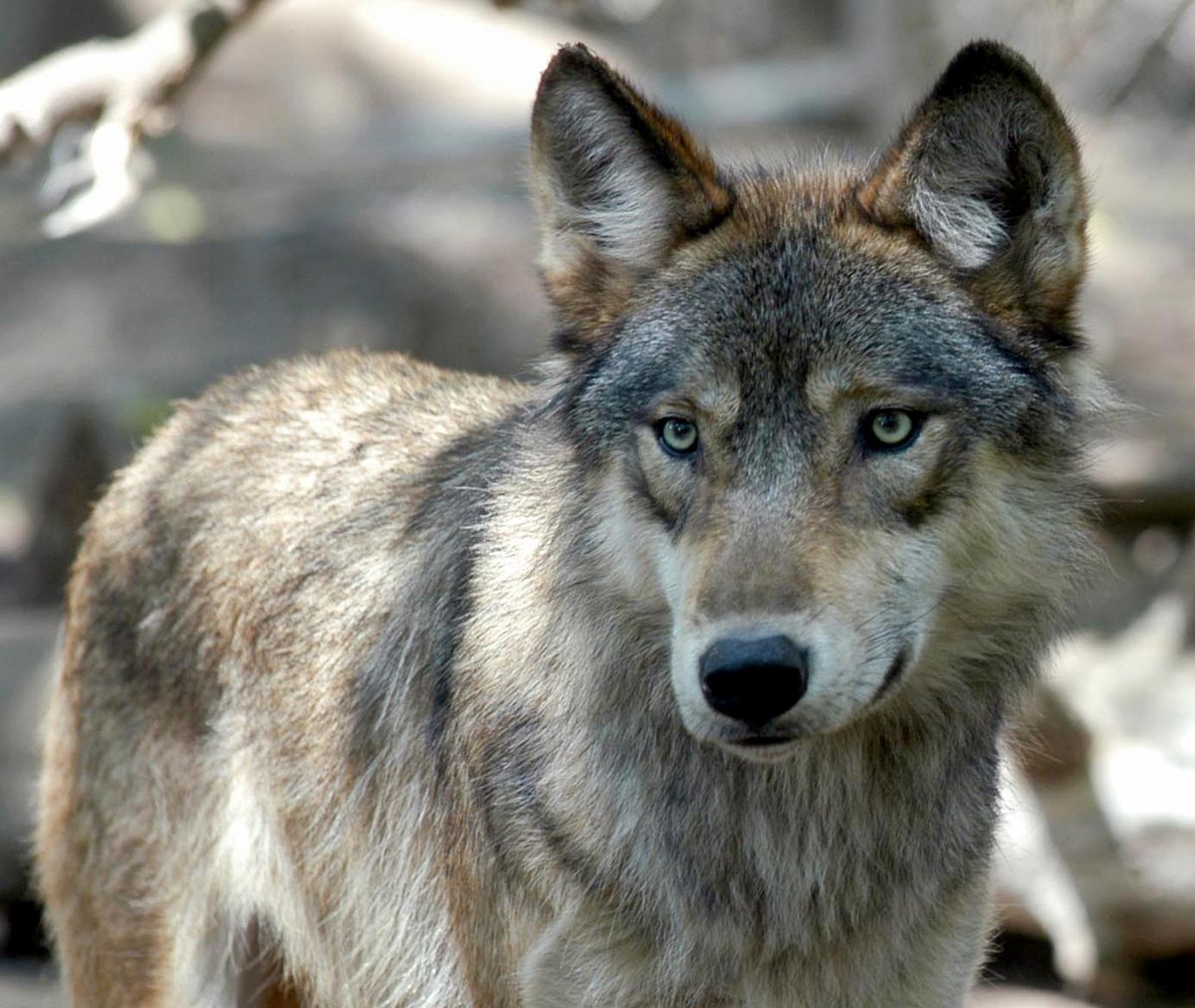Gray wolf recovery projects continue to drain millions of dollars from state coffers
Washington Fish and Wildlife Department wildlife biologist Scott Becker records data on a yearling female gray wolf captured in a trap so it can be fitted with a GPS collar and released. (Rich Landers / The Spokesman-Review)Buy a print of this photo
Wolves don’t come cheap.
Since the U.S. Fish and Wildlife Service reintroduced gray wolves to Yellowstone National Park and central Idaho two decades ago, the legendary carnivores have increased their numbers to more than 2,000 and spread into Washington, Oregon and beyond.
The feds initially estimated in the 1990s that approximately $7 million would be spent ushering wolves to recovery in the Northern Rockies. Wolves were removed from the Endangered Species protections in Idaho and Montana in 2011 – eight years after wolf numbers had exceeded the minimum set for recovery in both states. But millions more continue to be spent by federal and state agencies dealing with the wolf’s return.
Livestock grazing on both public and private lands are on the front line of impacts.
“Other predators are not even in the same league in terms of damage complaints,” said Todd Grimm, director of the U.S. Department of Agriculture’s Wildlife Services Program for Idaho.
“Idaho has around 20,000 black bears and 2,500 mountain lions. They’re of similar size to wolves, occupying roughly the same space, yet those two species cause very little conflict in terms of livestock compared with wolves.
“Idaho probably spends less than $10,000 dealing with depredation by bears and cougars,” Grimm said. “Last year, $576,357 was spent dealing with wolf depredation.”
Idaho also addresses wolf management through the governor’s Office of Species Conservation with $800,000 split between the Idaho Fish and Game Department and the tribes.
Even though the U.S. Fish and Wildlife Service has cut back on wolf recovery funding to Idaho and Montana, the agency reported spending $7.4 million on gray wolf programs across the country in 2014.
One thing wolves and wolf managers have had going for them is the good habitat and generally abundant prey when recovery commenced.
Whatever is being spent on wolves pales to the $263 million the federal government spent in 2014 on steelhead trout, which are protected in 11 separate managed populations. Steelhead and salmon are struggling in habitat compromised by dams and tributary damage. Endangered species funding for nine stocks of chinook salmon totaled $240.7 million.
But any added program cost can be a financial challenge for chronically cash-poor state wildlife managers.
Federal funding still defrays some expenses for addressing wolf attacks on livestock, but the states are largely on their own for financing wolf monitoring and other costs. “We used to get $800,000 a year in federal funding, but that’s gone,” said Jim Hayden, Idaho Fish and Game’s lead wolf biologist.
Even after delisting, Montana and Idaho are still responsible to the U.S. Fish and Wildlife Service for assuring at least 150 wolves and 15 breeding pairs in each state to avoid endangered species protections from kicking in again.
Washington, which is still in wolf recovery mode, has an annual budget from all funding sources of nearly $2.9 million. That amount will be decreased by about 50 percent in the next biennium, said Donny Martorello, Department of Fish and Wildlife wolf policy lead.
Where wolves are delisted, sales of wolf hunting and trapping licenses raise $437,000 a year in Idaho and $400,000 a year in Montana.
But wolf hunting is not allowed in Washington, where wolves are still protected by state endangered species rules in the eastern two-thirds of the state and by federal protections in the western portion.
Sales of personalized endangered species license plates provide $900,000 a year to Washington’s wolf program, Martorello said.
In addition, wolf management is receiving $220,000 from the state wildlife program, $90,000 from federal Pittman-Robertson taxes on shooting and hunting equipment, $64,000 from federal species recovery funds and $61,500 from the state general fund plus other grants that are competitive and not reliable.
The current bulge in wolf funding stems from a $2.2 million special appropriation from the Washington Legislature for 2015-2017. Of that, $850,010 was spent on a two-year contract with conflict-resolution consultant Francine Madden to guide the Wolf Advisory Group citizen panel ranging from ranchers to wildlife protection groups to consensus on wolf management.
The group in the past year has explored deterrents to wolf attacks on livestock and hammered out a protocol for lethal removal of wolves as a last resort.
A wolf-livestock conflict budget includes $497,000 for staff time. Washington has three people working full time on wolves plus roughly two dozen conflict specialists who work on wolf issues as well as a wide range of other problems such as big-game damage to crops.
“The conflict specialists in northeastern Washington spend a lot more of their time on wolves than the specialists in other regions,” Martorello said. “When they work on wolves, they bill to that account – when they deal with deer or elk eating a farmer’s crops, their time is billed to another program.”
The conflict budget also includes $61,000 for compensation and $38,000 for lethal removal of wolves if needed. The lethal removal budget was exceeded in 2016 as the bill for removing most members of the cattle-killing Profanity Peak Pack totaled $135,000.
Wolf-livestock research support for Washington State University graduate students accounted for $600,000 of the special appropriation and $400,00 was earmarked for a five-year predator-prey study that’s underway.
Wolf population monitoring has been a costly burden to all of the states involved in wolf recovery. Washington currently is spending approximately $425,000 a year for trapping, helicopter captures and surveys, collaring and year-round study.
“As the wolf population grows, it gets harder and more expensive to try to maintain a collared wolf in every pack for keeping tabs on them,” Martorello said.
The amount Idaho spends for monitoring wolves has been cut by roughly 90 percent since wolves have been delisted and most federal monitoring requirements have expired. “But it’s still really expensive and not very useful for management,” Hayden said.
Idaho is investing roughly $500,000 to develop new “occupancy modeling” techniques. If using DNA samples, hunter reports and remote camera images can replace helicopter captures, GPS collars and surveys, Idaho can reduce its monitoring costs to about $50,000, Hayden said.
“The state isn’t working with a million dollar budget anymore,” he said.
Washington also is banking on perfecting that sort of monitoring technique, Martorello said. “Snagging hair samples for DNA and photos from remote cameras would allow us to use volunteers and citizen science to lower costs,” he said.
In fiscal year 2015, Idaho budgeted $1.63 million for wolf related expenditures including depredation, enforcement, hunting-trapping oversight, monitoring, research and administration.
“This was the last year under federal oversight,” Hayden said. “It was an exceptionally high year – we wanted to make dang sure we had all the bases covered. Now our monitoring will be much different, and costs are much lower.”
Wolves occupy roughly 50 percent of Idaho – an area that exceeds what’s been identified as quality wolf habitat, Hayden said. The number of wolves is approximately five times more than the federal minimum of 150.
Nevertheless, wolves are coming into some sort of equilibrium on the landscape.
“Since hunting and trapping was authorized, pack size decreased about 25 percent while territory size remains about the same,” he said.
“That means reduced density and food requirements per pack, which has resulted in a substantial 57 percent decrease in livestock depredations. That saves the state money.”
“All of those things point to a good path. Elk survival has increased – 96 percent cow elk survival and high calf survival statewide last year,” he said. The numbers likely will be lower this year because of the tough winter conditions, he said.
The bottom line, Hayden said, is that wolves don’t need millions of dollars of management to do well on their own in Idaho even with managed hunting and trapping seasons.
“One thing about wolves, they’re prolific,” said Bob Inman, Montana Fish, Wildlife and Parks Department carnivore and furbearer coordinator. “It’s hard to overdo management actions. They’re resilient and people have gotten more used to them being around.
“Wolves definitely have arrived as a cost that wasn’t out here in the previous 100 years. It’s definitely not going away, but it doesn’t have to be so high.”

